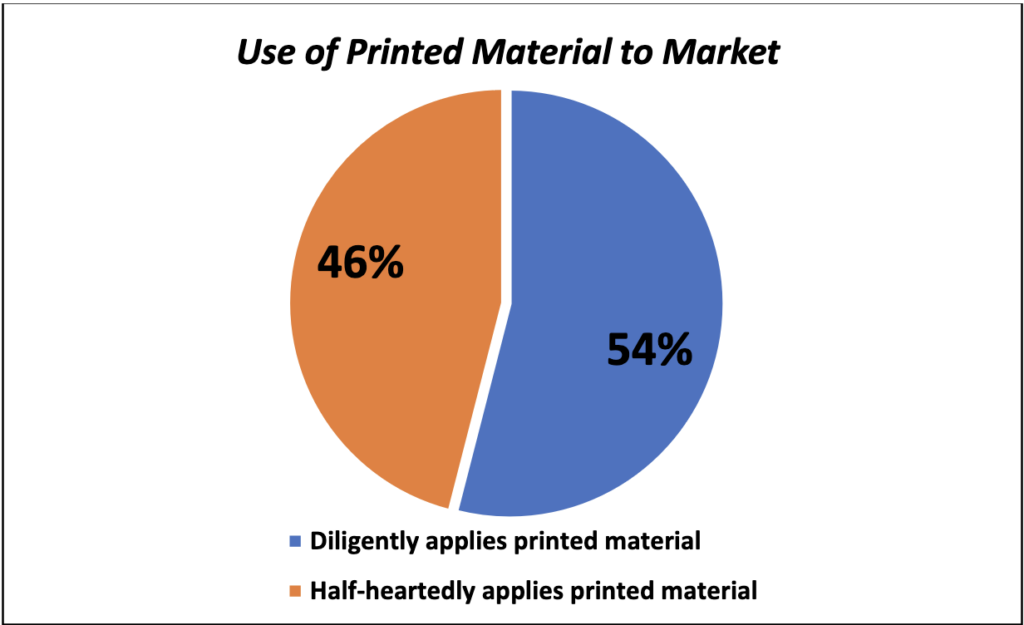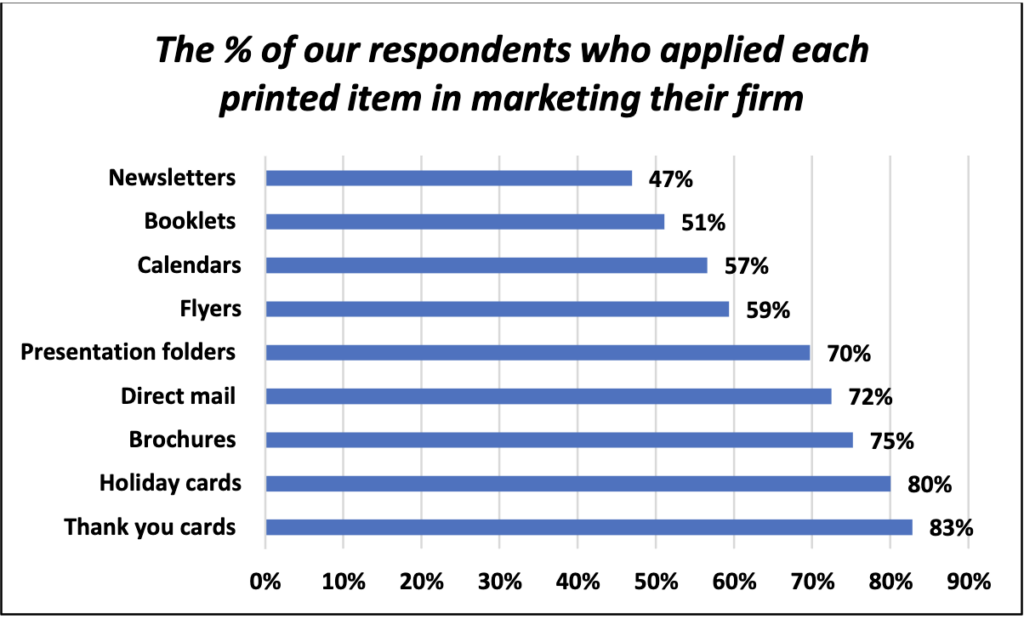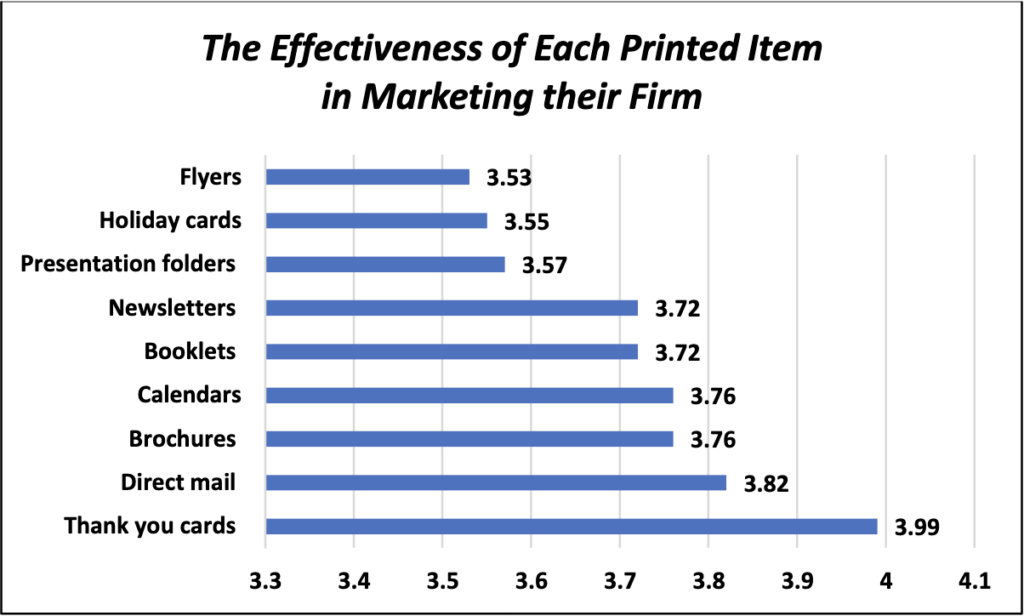Thoughts from a “Printing Industry Performance & Insights” study
Dr. Ralph Williams Jr.
Associate Professor of Management
Jones College of Business
Middle Tennessee State University
Dr. Randy Clark
Associate Professor of Marketing
Jones College of Business
Middle Tennessee State University
Our April 2022 “Printing Industry Performance & Insights” study focused on sales management and marketing in printing firms. In that survey, we asked leaders if they used printed products to promote (market)1 their businesses. One hundred and forty-five printing company leaders answered that question by choosing one of these five options: never, rarely, sometimes, often, or always. From those five options, we separated the responses into two groups.
- We grouped those who answered often or always as “diligently applies printed material to market their business.”
- We grouped those who answered never, rarely, or sometimes as “half-heartedly applies printed material to market their business.”
The pie chart below shows the percentage of respondents in each group.

Yes, more respondents (54%) diligently apply printed material to market their business than those who half-heartedly apply print (46%). However, given we surveyed printing companies, we expected a much stronger presence of persistent use of printed marketing materials. Nearly one-half of the printing companies in our survey do not vigorously use printed materials to market their business. Not seeing a much larger proportion of printing companies diligently using printed material as marketing tools was striking.
In our studies, we apply subjective questions to assess firm performance. Respondents answer questions on a one-to-five scale. Interestingly, it appears that printing firms who diligently apply printed marketing tools outperform those who half-heartly apply printed marketing material. Those diligently applying printed materials averaged 3.62 out of five, and those half-heartly applying printed materials averaged 3.29 out of five.2 So, below, we provide potential benefits of using printed materials to market your firm.
- Through the use of printed material to market your firm, show customers how they can use printed materials to market their firm.
- If you effectively use printed materials to market your firm, your current and potential customers may see value in printed materials.
- Help open the door to new prospects.
- Sending a prospect printed material promoting your firm before a salesperson’s first contact may help your salesperson get a foot in the door quicker and get it in deeper.
- Differentiate your firm.
- With the abundance of spam emails, perhaps trying a different marketing tactic may help draw more attention to your firm. As we see in articles about printed material, its tangible nature may cause your message to “stick” better than messages from firms relying totally on online communication or sales calls. The abundance of online communication, the tangible stickiness of printed material, and the indication in our findings that not all printing companies diligently use printed materials to market their firm, may point to the possibility of differentiating your firm by using printed material to market your firm.
- Demonstrate the quality of your work.
- A prospect may wonder about the quality of your work. In using printed products to market your firm, a prospect may see quality and creativity in what your firm produces to market itself. You may also showcase in your marketing printing material effective printed products you produce for other firms.
- Help in the development and reinforcement of your strategy.
- In developing printed marketing material, you should consider at least two questions: Who is our target market? And, what value do we provide our target market? In other words, with whom do we communicate, and what’s our message (our mission)? Considering these questions will promote strategic thinking – developing and directing the message. The production of promotional printed material directed at your target market and communicating the value you deliver may also reinforce your firm’s strategy among internal stakeholders, such as employees, managers, sales personnel, and leaders.
- Provide testimonials of your firm’s use of printing to market itself.
- If your printing firm experiences positive results from using printed material in marketing, you might share those stories with your prospects and customers. For instance, if mailing newsletters helps draw your prospects’ attention, you can share that outcome with your customers.
- Leverage your capabilities and resources.
- The primary reason many businesses have moved away from using printed materials and to online marketing is the cost. As your firm produces printed material, it costs you less to produce printed material for your firm than it does non-printing firms. Therefore, it’s easier for your firm to gain a return on investment in promotional printed products.
Seeking more knowledge, we asked respondents about nine printed items (listed in the tables below). The first table below shows the percentage of respondents that applied each printed item to market their company. Interestingly, holiday cards and thank-you cards were shown mostly used by printing firms. One would expect more printing companies to report using the other items.

We also asked respondents about the effectiveness of each item in marketing their firms. Respondents answered using a one-to-five scale – Definitely not effective (1) to Definitely effective (5). As shown in the figure below, thank-you cards were shown as the most effective.

Take the findings shown in the two figures above with a grain of salt. Do those findings mean that you absolutely should print thank-you cards for your company to use… No. But you might consider thank-you cards as an option.
Here’s the big message – Consider producing printed products to help market your printing business. Consider multiple options and consistently use what printed products you choose. Here are a few obvious options:
- Use direct mail postcard campaigns to introduce your firm, and maybe a specific salesperson, to prospective customers. Using this tool may prompt an ongoing search for new prospects.
- Produce flyers showing printed products you previously produced and how those items helped your customers.
- Generate booklets that include a plethora of products your firm has produced. A booklet may prompt customers to consider printed material options.
- Provide printed brochures for your salespeople to give to customers as they make in-person sales calls. A brochure may illustrate your production capabilities. If your firm provides a service that complements printing (e.g., web-to-print, fulfillment, marketing consulting, photography, design, or others), you might develop a brochure for each service.
- As another brochure option, you might produce a brochure highlighting your company’s history, values, or culture.
- You might mail flyers or cards highlighting company news, such as new equipment, company awards, employee awards, employee promotions, philanthropic activities, and others.
- You might continue to develop thank-you and holiday cards that directly connect to your company – instead of a generic card. You might continue to redesign cards, so recipients see a new design each time they receive a card from your company.
Are there other options? Sure. Have your team apply critical thinking to develop options that will help market your firm, open the eyes of prospects and customers to how they can use printed products, and differentiate your printing firm from competitors.
Bottom line – Printing company leaders, consider using printed items to communicate the value your firm brings customers, to contact prospects, to demonstrate the quality and value of your firm’s product and services, and to reinforce your firm’s mission internally and externally. Our findings suggest that printing leaders don’t overwhelmingly use printed products to market their firms.
Consider using printed products to make your printing firm stand out. However, strategically consider and apply the BEST ways to market your firm.
If you have thoughts, please email Dr. Ralph Williams at ralph.williams@MTSU.edu
- We used the word “promote” in our survey question. But we refer to that as “market” or “marketing” in the balance of this article. ↩︎
- To avoid survey bias in our future studies, we don’t share a lot of details here about our subjective firm performance questions. Sorry. However, previous research has shown our subjective firm performance questions valid and solid. ↩︎


